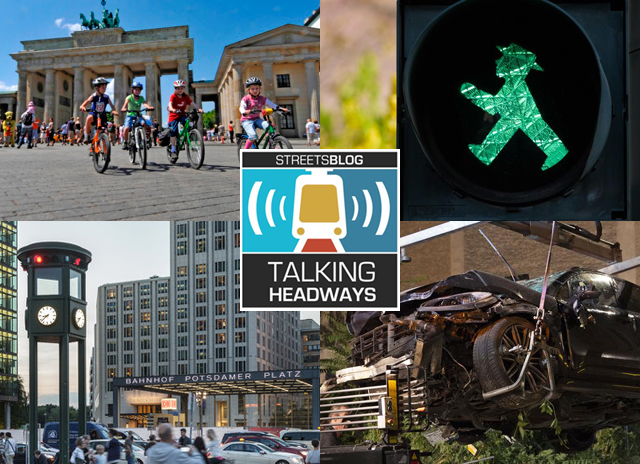This week we’re joined by Roland Stimpel of the German Pedestrian Association Fussverkehr. Stimpel chats with us about Berlin’s new mobility laws, including the 2018 Mobility Act and 2021’s pedestrian law amendments. We also talk about SUVs, the struggle to find public servants, and Ampelmännchen, the traffic-light man.
For those of you who get your news through your eyes and not your ears, there’s an edited transcript below the audio player. If you want a full unedited transcript (with some typos!), click here. If you want to listen, here you go:
Jeff Wood: Well, I’m curious. What about the Mobility Act, before we get to the pedestrian stuff, I’m curious, was it mostly about safety? Was it about climate action? What were the driving forces behind it?
Roland Stimpel: So, of course, safety and making cycling more attractive was the drive behind it and more attractive means. Fewer accidents, a better feeling of being safe, and fewer obstacles like parking cars on bikeways, like getting away the cycleways from congestion so that you can drive right through the next traffic light, whereas cars have to stand in long lines and wait, getting traffic lanes different or put them away so that you can go right through and things like that. Getting more and better parking space for bicycles, which is a problem, too. You have been to Amsterdam; you’ll know they’re all over. But what was the core of the law was about the infrastructure, was about cycleways at least two meters wide, as I said, thousand kilometers of them, and even a hundred kilometers of fast cycling lanes where cyclists always have the right of way, where they have as little crossings as possible, which we oppose partly because they plan these not through streets everywhere, but through greenery where people will walk and where people relax.
Wood: Yeah, it’s an interesting opposition because usually you’d be on the same side, but I completely understand you don’t want to take away greenspaces for just more traffic, even if it’s cycling,
Stimpel: That’s great to have bicycles on the road. Any bicycle is better than any car. The reasons are obvious: no pollution, no noise, more safety, fewer space they need. So that’s great. But driving devices with two wheels, like cycles, like motorbikes, like e-scooters, they have one huge disadvantage for pedestrians because they tend to use pedestrian space too. They drive and park on sidewalks in parks and public squares and everywhere. And there, we get a conflict with them. So, on the one hand, great on the road, but bad on our space.
Wood: So I wrote down some of the stipulations for the Mobility Act, a hundred thousand new [bike] parking spaces, 200 million euros for bike infrastructure, like you’re talking about, redesigning 20 dangerous intersections, a year, 60 new public employees for implementation. You said it’s been hard because of the lack of planners potentially to make this actually happen.
Stimpel: For four years they tried to find these people, but didn’t find them. You need trained traffic engineers, and these trained traffic engineers get double money if their work in private companies or planning agencies. They get money and they don’t have to go to free citizens meetings every evening, citizens meetings every week — and don’t get eaten.
Wood: Don’t get yelled at. Oh, that’s interesting. I would’ve thought that working in city government you’d get paid a little better, but I guess not.
Stimpel: No, no, no, no, no. They pay a bit better than they used to, but because of the lack of planners, the companies can pay more. And so they end up in private economy instead of at state agencies.
Wood: And you’re not going to go back into planning to get this done. Are you?
Stimpel: Well, I’m 64 years old now. And it’s great. It’s a full-time, non-paid job at the pedestrians association. So I’m in planning, but not.
Wood: You’re a good advocate. Well, so here we are in 2021, and earlier this year, there was an amendment to the law to increase pedestrian safety. So was that always the plan, to do bikes and transit and infrastructure for that, and then move on to pedestrians?
Stimpel: It was a plan to do this from the beginning, but they began with the cyclists who were strongest at that time. Then they added some pedestrian paragraphs and what’s in there. It’s great. It says more and better road crossings, like zebra lines, better situation on traffic lights, more green times to go, wider sidewalks, really planned priority walking connections, safe from parts of suburban city centers to the next station or to the schools or things like that. Everything is fine. Lots of good and great ideas. As it always is, the difficulty is not writing all those ideas in the law, but to implement them in the real world.







